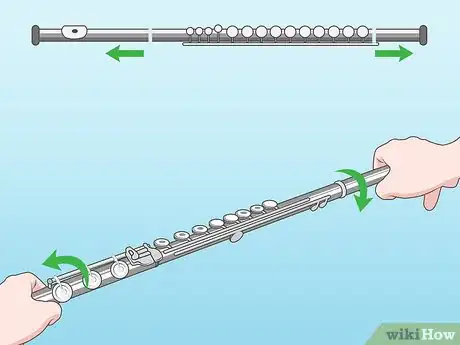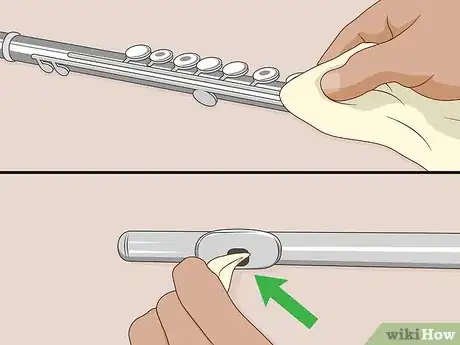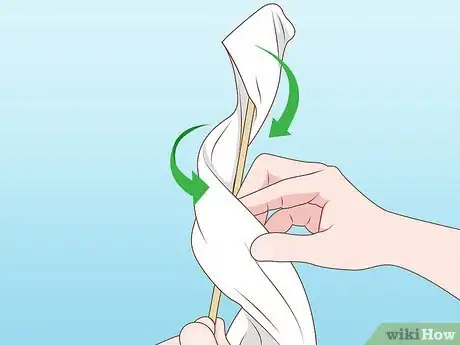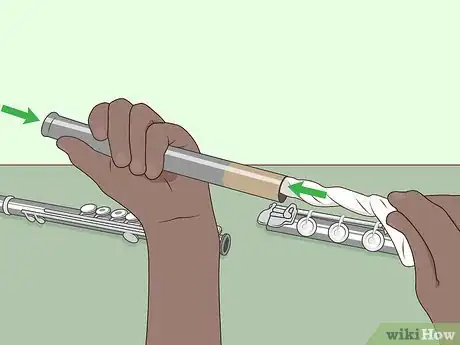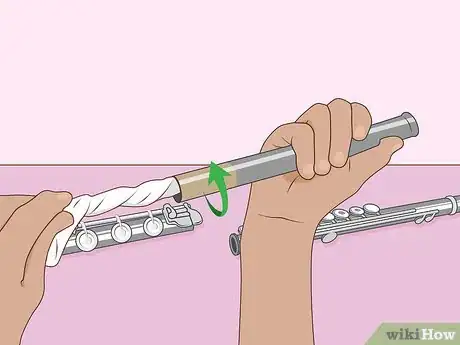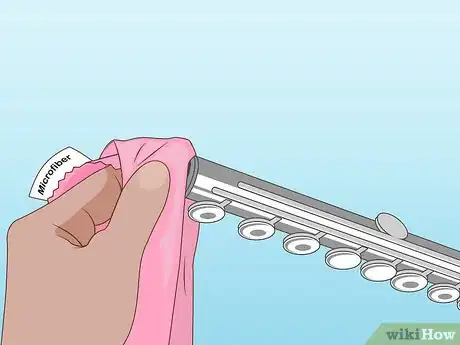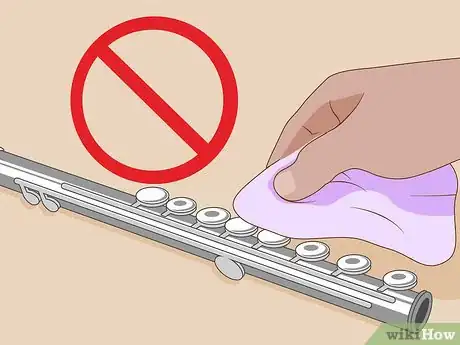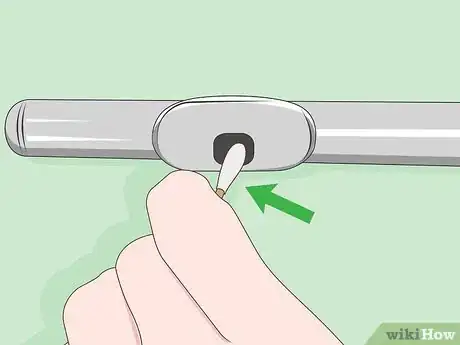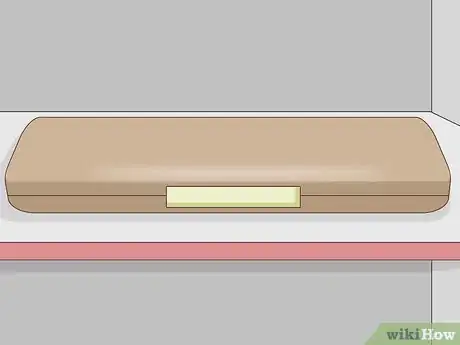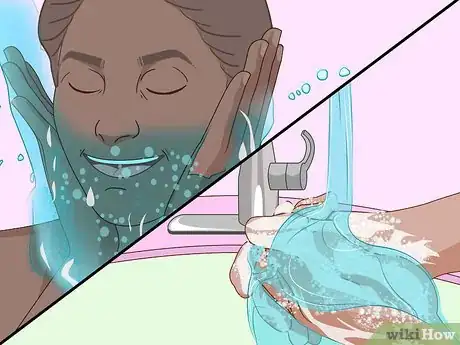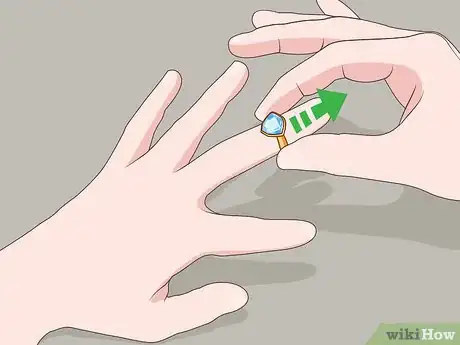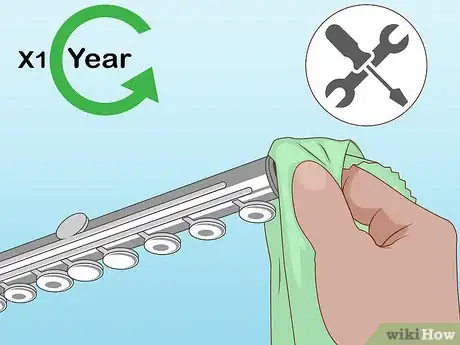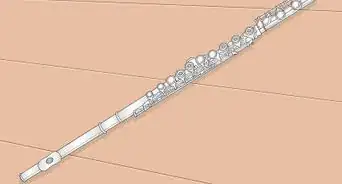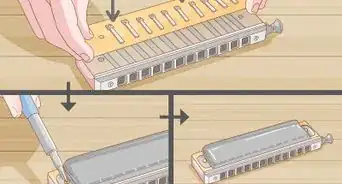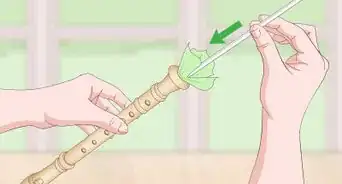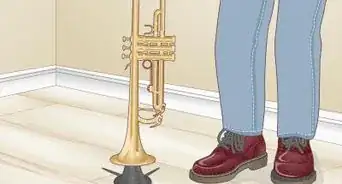This article was co-authored by wikiHow Staff. Our trained team of editors and researchers validate articles for accuracy and comprehensiveness. wikiHow's Content Management Team carefully monitors the work from our editorial staff to ensure that each article is backed by trusted research and meets our high quality standards.
wikiHow marks an article as reader-approved once it receives enough positive feedback. In this case, 85% of readers who voted found the article helpful, earning it our reader-approved status.
This article has been viewed 404,461 times.
Learn more...
Your flute is an expensive and valuable instrument that needs to be properly cleaned and cared for to remain in good condition. It is extremely important that you clean your flute after each use. Gently handle your flute while assembling and disassembling it, and always store your flute in a safe space.
Steps
Cleaning Your Flute
-
1Unscrew the pieces gently. In order to take apart your flute, gently unscrew the head-joint and foot-joint from the body of the flute. This should be done carefully. Be sure not to touch the keys or keypads because these can easily be damaged.
-
2Clean your flute after each use. Before you put away and store your flute, it is important that you remove the moisture from inside. If left uncleaned, your flute will not only begin to smell, but it will also tarnish on the inside. As a result, you should clean the inside and outside of your flute after every use.Advertisement
-
3Attach a cloth to the cleaning rod. Thread a soft cloth through the needle-like slot in the end of your cleaning rod. Pull the cloth through the slot so that half of the cloth is on either side of the rod.[1]
- Use a cloth made from a soft and thin material, such as a microfiber or cotton.
-
4Wrap the cloth around the rod. Take the cloth and wrap it around the rod so that none of the rod is exposed. If the rod touches the flute while cleaning, it can scratch and damage the inside of the flute.
-
5Insert the rod into each section of the flute. Remove the moisture that builds up inside the flute, by gently inserting the cleaning rod into each section of the flute. For example, you will need to clean inside the head-joint, foot-joint, and body of the flute. The cloth will absorb and remove any moisture inside.
- When cleaning the body section of the flute, be sure to insert the cleaning rod into both ends of the flute. This will ensure that the entire inside is cleaned.
-
6Twist the rod to clean inside. You can gently twist the cleaning rod while it is inside the flute to ensure that all the moisture is absorbed.[2]
-
7Wipe the outside of the flute with a cloth. Carefully polish the flute with a microfiber cleaning cloth. While playing, grease and fingerprints can build up on the outside of the flute. Gently clean all of the keys and the body of the flute.
- Pay particular attention to the ends (or tenons) where the separate pieces attach together. This is where gunk can often build up. Use your fingers and a cloth to clean around and inside the ends.
- Do not use cloths that contain metal polish. These can damage your flute and should be avoided.
-
8Don’t touch the key pads while cleaning. When you are cleaning, be sure to hold the flute by the barrel and avoid touching the key pads. These can be easily punctured and will cause damage to your flute. You can also bend the keys if you are too rough while cleaning.
- If the key pads or keys are damaged, take your flute to a professional for servicing and repair.
-
9Use a cotton swab to clean tough to reach places. You can use a cotton swab to remove dust and buildup between the keys. A cotton swab can also be used to clean the embouchure hole on the head-joint. Be very gentle and avoid touching the keypads.[3]
Storing Your Flute
-
1Place the individual pieces into the case. Make sure to always store your flute in the case. If you leave the flute out of the case it is more likely to get damaged. Do not store the wet cleaning cloth inside the case with the flute. This moisture could tarnish the flute.[4]
- Instead, place the cloth in an outer pouch on the case.
-
2Store in a safe place. Place your flute case in a closet, under your bed, or in a low traffic area of the house. You do not want the case to get knocked over or banged around. This could damage the flute inside.
-
3Avoid storing your flute in extreme temperatures. Extreme hot and cold temperatures can affect the mechanics of the flute as well as the pads and the cork inside of the top of the headjoint. Heat can expand it, destroying the top of the headjoint and coldness can shrink the cork, resulting in bad tone and tuning issues. Make sure you store your flute away from radiators or windows with direct sunlight.[5]
Caring for Your Flute
-
1Wash your hands and face before playing. Your hands and mouth may have grease and oils on them that can be transferred to your flute while playing. In order to reduce the amount of grease that comes in contact with your flute, wash your hands and face before playing. This will also reduce the amount of fingerprints that transfer to your flute.[6]
-
2Remove any jewelry prior to playing. Jewelry, especially rings, can scratch or damage the exterior of your flute while you are playing. To reduce this potential damage, remove your rings before you play the flute.
-
3Get your flute serviced at least once a year. A professional will be able to clean and adjust the keypads without causing damage to the instrument. They can also take apart the smaller pieces of the flute for cleaning, tuning, and repair. To properly maintain your instrument, you should have it serviced at least once per year.
Community Q&A
-
QuestionA friend played my flute when she had a cold. How can I disinfect it?
 Community AnswerYou need to get a spray to clean your mouthpiece. It's called Giardinelli Magic Mist Hygienic Mouthpiece Cleaner. Spray it on your mouthpiece, and wipe it off with a soft cloth. This will disinfect your mouthpiece.
Community AnswerYou need to get a spray to clean your mouthpiece. It's called Giardinelli Magic Mist Hygienic Mouthpiece Cleaner. Spray it on your mouthpiece, and wipe it off with a soft cloth. This will disinfect your mouthpiece. -
QuestionHow do I remove rust from a flute?
 Community AnswerYou could try using some toothpaste on a piece of cloth and rubbing it in gently, but it is not recommended if the rust is near any keys or pads, as toothpaste literally destroys pads. Otherwise, just get it professionally cleaned, it only costs about $15.
Community AnswerYou could try using some toothpaste on a piece of cloth and rubbing it in gently, but it is not recommended if the rust is near any keys or pads, as toothpaste literally destroys pads. Otherwise, just get it professionally cleaned, it only costs about $15. -
QuestionHow do I remove stains on a flute caused by oils on my hands?
 Community AnswerUse a microfiber cleaning cloth to wipe the oil off your flute.
Community AnswerUse a microfiber cleaning cloth to wipe the oil off your flute.
Warnings
- Never clean the body of a flute with any product that contains bleach. You will destroy the finish on the flute. The entire finish will lose its luster and shine.⧼thumbs_response⧽
- Woodwind instruments can't get wet! If you let your flute gets wet, the pads will swell up, and the flute won't play.⧼thumbs_response⧽
- Be careful not to bend any keys when you are dismantling the flute. Be especially careful when removing the foot-joint because it has a very complicated and delicate key connection that is easy to bend and is expensive to replace.⧼thumbs_response⧽
Things You'll Need
- Cleaning rod
- Cloth to clean inside the flute
- Polishing cloth
References
- ↑ http://www.shinemusic.com.au/musicresources/maintain-flute.aspx
- ↑ http://www.shinemusic.com.au/musicresources/maintain-flute.aspx
- ↑ http://www.shinemusic.com.au/musicresources/maintain-flute.aspx
- ↑ http://www.mostlywind.co.uk/care.html
- ↑ https://www.jennifercluff.com/care.htm
- ↑ http://www.shinemusic.com.au/musicresources/maintain-flute.aspx
About This Article
You should clean and maintain your flute after each use. To clean it, gently unscrew the head-joint and foot-joint from the body of the flute, then wrap a soft cotton or microfiber cloth around your cleaning rod. Gently pass the cloth through each section of the flute, twisting the rod to ensure any moisture inside of the flute has been absorbed. Carefully polish the outside of the flute, including the keys, with a clean microfiber cloth. Avoid touching the key pads while you are cleaning, since they are easy to damage. To learn more, like how to properly store your flute when you aren't playing it, keep reading the article!
